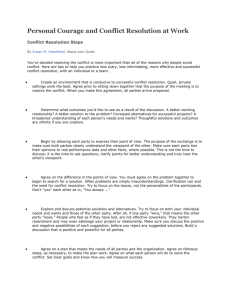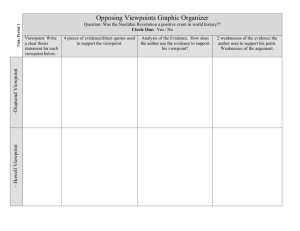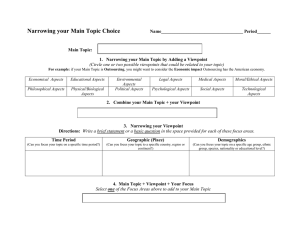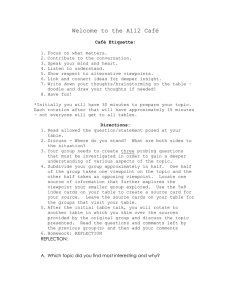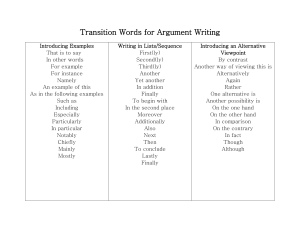General Vision & Viewpoint Sample Answer: Wuthering Heights
advertisement
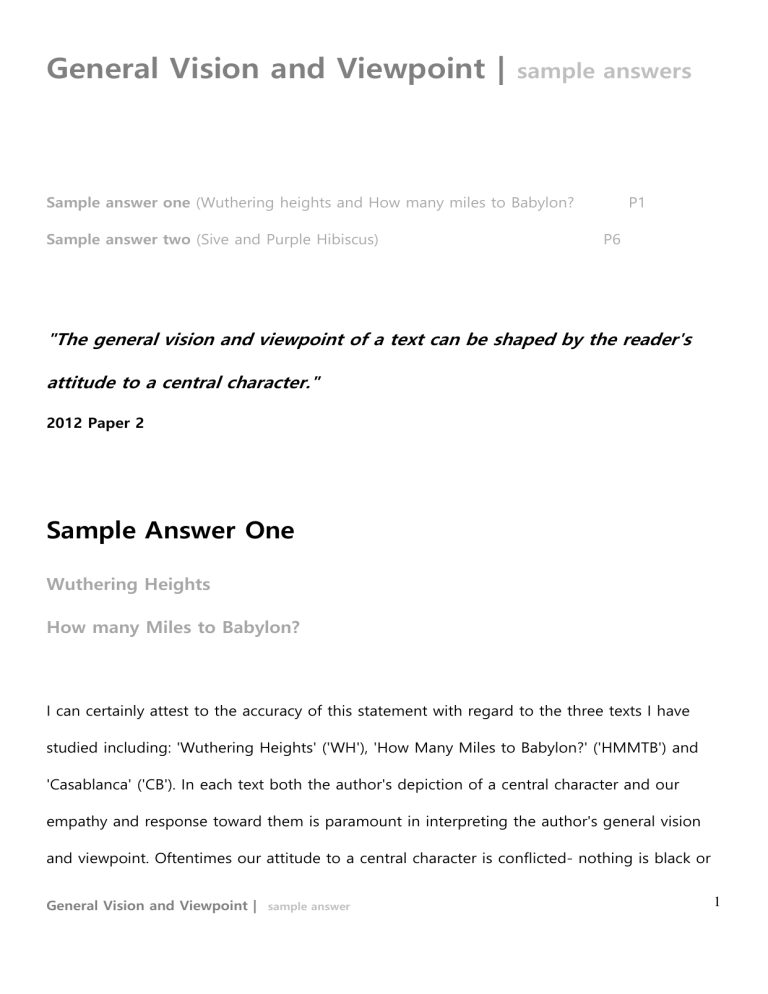
General Vision and Viewpoint |
sample answers
Sample answer one (Wuthering heights and How many miles to Babylon?
Sample answer two (Sive and Purple Hibiscus)
P1
P6
"The general vision and viewpoint of a text can be shaped by the reader's
attitude to a central character."
2012 Paper 2
Sample Answer One
Wuthering Heights
How many Miles to Babylon?
I can certainly attest to the accuracy of this statement with regard to the three texts I have
studied including: 'Wuthering Heights' ('WH'), 'How Many Miles to Babylon?' ('HMMTB') and
'Casablanca' ('CB'). In each text both the author's depiction of a central character and our
empathy and response toward them is paramount in interpreting the author's general vision
and viewpoint. Oftentimes our attitude to a central character is conflicted- nothing is black or
General Vision and Viewpoint | sample answer
1
white, the author blurs the lines of distinction between right and wrong, fair and unjust.
Throughout my study of the comparative the central characters that I have encountered are
those built on many complexities. The multifariousness of each character forces the reader to
engage their intellect, account for these variegated complexities and understand the dynamics
associated with the author's general vision. Whether it's Heathcliff and his trail of abhorrence,
or Rick, lurking behind his façade of cynicism, or even Alec, wallowing in his world of
isolationism, all of these central characters have something in common; hardship and suffering.
These aspects are the fundamental structures to the complexities we talk about. They may
either conflict or reiterate our attitude towards the central character and they enhance and aid
us in the process of delineating the author's basal paradigm, inclusive of the general vision
and viewpoint.
Heathcliff in 'WH' correlates with the above statement given his childhood circumstances. An
orphan from the poverty stricken county of Liverpool, adopted into the heights by Mr.
Earnshaw, grew up tortured by his childhood tormentor Hindley, whose "treatment of the
latter was enough to make a fiend of a saint." Heathcliff is the immediate elicitation of
negativity in the novel, the very negativity which contributes to a rather sombre and grim
vision and viewpoint, "from the very beginning he bred bad feeling in the house". He was a
"usurper" of Mr. Earnshaws affections, and as a result he suffered the brunt of Hindley's anger.
Similarly, in 'CB', Rick is initially seen immersed in his own misery, surrounded by a corona of
pessimism as he sits alone, refusing to accept drinks from customers, indifferent to the war
that is being waged around him and the desperate refugees flocking into Casablanca and
ignorant of the affections of his lover Yvonne. Like Heathcliff, we can see that Rick is a man of
General Vision and Viewpoint | sample answer
2
mystery, a man with a traumatic past of hardship. However this is not revealed to us until later
in the film. Rick's suffering isn't developed in the film as well as Heathcliff's is in 'WH'.
As 'WH' progresses, an abstract divisive barrier is established between himself and the
inhabitants of 'WH'. He is deemed unworthy of their companionship according to the
Georgian society's bible of social normality. After all, Heathcliff is "the imp of satan", and a
"gypsy ploughboy". It is only Catherine Earnshaw who choses to identify with him and befriend
him. It is through his relationship with Cathy Heathcliff relieves himself of the cruelty and
misery inflicted on him by Hindley. This relationship provided him with solace, a flickering
spectre of hope in the midst of his degradation and suffering. "Miss Cathy and he were now
very thick."
As is the case for Heathcliff, Alec Moore in 'HMMTB' finds himself confined to the world of his
sparring parents; an ineffectual but genuine father and a cold, manipulative mother. The awful
tension between two people at war with one another and the effect of these hostilities on
their child is convincingly captured in the first part of the novel. "Their conversations were
always the same, like some terrible game, except that unlike normal games the winner was
always the same. They never raised their voices, the words dropped malevolent and cool from
their well bred mouths." By her own admission, this may be due in part to Johnston's own
experience of the break of her parent's marriage when she was a child and her own divorce
from her first husband. Like Heathcliff, Alec lived in isolation, an isolation brought about by
society and the hierarchy of social standing; "I was isolated from the surrounding children of
my own age by the traditional barriers of class and education." Alec tries to escape the
General Vision and Viewpoint | sample answer
3
limitations and confines imposed on him by forging a proscribed relationship with Jerry Crowe,
someone from the opposite side of the great social, religious and political divide. "I had a
friend, a private and secret friend, I never went to his house nor he to mine." Like Heathcliff's
relationship with Cathy, Alec finds relief and comfort from his statically bleak reality in his
relationship with Jerry.
The introduction to central characters in a text is vital in elucidating the fundamental
structures of the author's general vision an viewpoint. Without the insight into Heathcliff's dire
circumstances or Alec's solitude, our understanding of the author's perspective would lack
much significance and reside in insipidity. In contrast to 'HMMTB' or 'WH', we are provided
with little acumen into Rick's plight. He sits at the bar, a haggard man, inured to both the
cruelties and the beauty of the world. There is a sense of mystery however, the viewer knows
immediately that this is a man with a past. The film leaves us in wonderer, questioning what
has caused this man to become so indifferent and so miserable. What has affected him so
profoundly that he resides with suspicion and lacks any faith in his peers? "I stick my neck out
for nobody".
Evidently, it is the character's previous situation and past trauma which may either conflict or
justify one's attitude toward them, one's delineation of the author's vision and viewpoint as
well as the character's actions thereafter. Perhaps it is their previous innocence or happiness
which is later corrupted by external factors that manipulates the reader to respond to them in
a certain way. For me, Heathcliff is the epitome, the perfect exemplification of this point. After
Cathy rejects in him in favour of being "the greatest woman of the neighbourhood" and
General Vision and Viewpoint | sample answer
4
marrying Edgar Linton despite her "eternal" love for Heathcliff, he leaves the heights for three
years. This is the first stage of Brontë's exploration of how treating an individual with great
cruelty can impact upon generations to come. The pain, both physical and mental, inflicted on
Heathcliff from a young age renders him feelingless to the plight of others and immerses him
in selfishness. However, it is Cathy's betrayal of him that truly elicits his desire for revenge on
those that have wronged him. His raison d'être is to seek relief from his heartbreak and
mistreatment by inflicting terror on all of those who dare cross his path. "I am trying to settle
how I shall pay Hindley back. I don't care how long I wait, if I can only do it at last, I hope he
will not die before I do." Hindley is Heathcliff's first target, once he gets a taste of the
destruction he causes, he continues his reign of terror in order to seek a satisfaction, a
satisfaction which doesn't in fact, exist.
Similarly, in 'CB', after Rick's flashback to paris with Ilsa, where we see them driving through
the streets of Paris, boating down the river Seine, dancing and opening champagne, we begin
to understand how Rick becomes so embittered by life- like Heathcliff. His torturous
separation from Ilsa and her betrayal of him has caused Rick to metamorphose into a man,
hidden behind his demeanour of insensitivity, sheltered by his mental walls of protection. We
learn that Rick is not coldhearted, rather, he is brokenhearted. Initially, upon Laszlo and Ilsa's
arrival into Casablanca, Rick angrily refuses to give them the highly coveted letters of transit;
"I'm the only case i'm interested in." However, as the story unfolds, Rick's protective barrier
diminishes, his façade of cynicism disintegrates. This is antagonistic to Heathcliff's cycle of
change, as Heathcliff surrenders with reticence to the overwhelming emotions of hatred and
anger, instead of overcoming his past.
General Vision and Viewpoint | sample answer
5
Heathcliff commits a string of morally reprehensible acts in 'WH'. He ensures Hindley drinks
and gambles away his entitlement to 'WH', he encourages Isabella's infatuation with him only
to treat her appallingly later on, he degrades Hareton; "I have him faster than his scoundrel of
a father secured me"; he tricks young Cathy Linton into visiting the heights and forces her to
marry his son Linton, all because he wants to see his descendant "fairly lord of their estates".
Heathcliff ensures that nobody associated with either the Earnshaws or the Lintons escapes the
indescribable pain and suffering which he was made to endure throughout his life. Brontë
does the same thing to the reader as Heathcliff does to Isabella, testing us to see how many
times we can be shocked by his gratuitous violence yet still, masochistically insist on him
being a romantic hero. Heathcliff defies being understood and it is difficult to resist seeing
what the author wants or expects us to see in him. We are teased with the possibility that his
cruelty is merely an expression of his frustrated love for Cathy, or that his sinister behaviours
serve to conceal the heart of a romantic hero. This is undoubtedly elemental of Brontë's
literary intellect which proves so vital in her ideation of vision and viewpoint. She raises an
important question as to whether one's own pain and trauma can be proportionate to the
pain and trauma they inflict on others. It reiterates her theory that by not allowing true
emotions to bloom and replacing them with anger, violence and desire to exact revenge, can
lead to resentment, hatred and eventually chaos. She exemplifies the lack of satisfaction yet
addictiveness associated with revenge. As Isabella infamously says; "Violence and treachery
are spears pointed at both ends, they wound those who resort to them worse than their
enemies."
General Vision and Viewpoint | sample answer
6
In contrast to 'WH' and 'CB', Alec Moore stands as a type of role model for Heathcliff. He does
what Heathcliff should have done in asserting his own humanity above the violence and horror
of war, the misery of his circumstances and his mother's betrayal of him. Unlike Heathcliff and
Rick, Alec refuses to be overcome by bitterness and anger. He is persistent and strong in his
moral standing and there is very little that alters this. Alec was self aware, he recognised the
possibility of becoming immersed in indifference, insensitivity, hatred, violence and anger; "I
was afraid that one day I might wake up and find that I had come to accept the grotesque
obscenity of the way we lived." It is difficult not to admire Alec, his whole life has been
marked by cowardice and indecision, though ironically, it is the one brave and decisive act
which both saves him and laments his tragic fate. Alec plays a major role in developing
Johnston's general vision and viewpoint, one which emphasises the futility of war. This,
however is paradoxical in relation to Heathcliff as Johnston, through the characterisation of
Alec, expresses the importance of maintaining one's morality and loyalty only to result in the
fatal end of Alec and Jerry. Where as in 'WH', Brontë emphasises the chaos and terror
resulting from one's surrender to hatred and anger, only to conclude with Heathcliff's
happiness, where he "sleeps the last sleep with that sleeper, with his heart stopped and cheek
frozen against hers."
As is the case for 'HMMTB', we witness Rick redeeming himself and salvaging his true heroic
nature. He finally recognises that "the problems of three little people don't amount to a hill of
beans in this crazy world."He sacrifices both his future with Ilsa and his comfortable life in
Casablanca so that Laszlo can escape with Ilsa and continue his important political work.
Instead of dwelling on this, he reassures Ilsa that they "still have Paris." Rick heroically puts his
General Vision and Viewpoint | sample answer
7
personal feelings aside for a greater cause and this is the very epitome of Michael Curtiz's
general vision and viewpoint.
In conclusion, it is most certainly evident that central characters are essential in shaping the
perception of the author's general vision and viewpoint of a text. The main character, their
actions, their relationships, their past and their psyche sit at the crux of the basic plot and
stand as the main factors in developing the authors general vision and viewpoint, whether
optimistic or pessimistic. They are instruments used to reiterate and elucidate various aspects
of morality and justice, whether it is Rick's patriotism or Alec's heroism and loyalty or even
Heathcliff's transition into a man wreathing in hatred and spite; these are ll significant
elements which help us cultivate an understanding of the author's main paradigm, their
perspective and general message attached to the text. However, our own attitude toward such
characters is also helpful in delineating the author's concept of general vision and viewpoint. It
helps us to overcome any lack of distinction or complexity which we may encounter on
interpretation by forcing the reader to engage in intelligent thinking.
General Vision and Viewpoint | sample answer
8
Sample answer two
Purple Hibiscus
Sive
“The GVVP of a text can be shaped by the reader’s attitude to a central
character” Discuss.
Writers often use their pieces of writing to voice their personal opinions or to persuade the
audience of their point of view of various topics. Each text is their unique canvas in which they
paint both their ideas and their opinions. It is such ideas which are examined during our study
of general vision and viewpoint. It cannot be denied that writer often uses their protagonist
and other central characters to persuade their audience of these opinions. This is certainly the
case in three texts I have studied during the comparative study, Nigerian novel ‘Purple
Hibiscus’ by Chimamanda Adiche, Irish tragedy ‘Sive’ by John B. Keane and Italian film ‘I’m not
Scared’ directed by Gabriele Salvatores. We see the cruelty and patriarchal nature of 1950’s
Ireland through examining the central characters in ‘Sive’. Similarly ‘Purple Hibiscus’ is used to
criticize a society, but this time 1990’s Nigeria. While it is incredibly dark and depressing at
times, it offers more hope and optimism for change than ‘Sive’. Likewise, ‘I’m not Scared’
explores disturbing themes while upsetting the viewer on occasions. However, through the
central characters it can also uplift them as they convey the power of friendship. During the
course of these texts, we can form a sense of the optimism or pessimism with which life is
portrayed. Each of these texts influenced my perspective on humanity while making me
question right from wrong. I was appalled by the cruelty of humanity but uplifted and inspired
General Vision and Viewpoint | sample answer
9
by the compassion and heroism conveyed in these texts. These emotions are developed as a
result of the development of each of the central characters. Each character plays an essential
role in presenting the viewpoint of the author as they voice their opinions on life, marriage,
gender roles and a range of other topics and themes.
From the opening of each text we form an opinion on the central characters. From the
opening of ‘Purple Hibiscus’ we learn that the family being portrayed is extremely
dysfunctional. On Palm Sunday, a sudden act of violence punctuates the repressed
atmosphere. Religious, domineering Papa throws a missal at his son Jaja for refusing Holy
Communion. Mama Beatrice and Kambili don’t interject and we realise that this violence isn’t
in any way out of the ordinary in this household. As a reader, I instantly formed a critical
opinion of Papa through Adichie’s negative descriptions of him. Similarly, tension is evident in
‘Sive’. The atmosphere appears far from affectionate and a sense of bitterness fills the air.
Mena and Nanna Galvin appear to be bickering, creating an uncomfortable environment.
There is no violence evident in comparison to ‘Purple Hibiscus’ but the atmosphere remains
just as tense. We learn from this key moment that ‘Sive’ also features a dysfunctional family.
From this evidence we form yet another critical opinion but this time of Mena. She insults her
mother-in-law repeatedly and appears rude and bad mannered. The opening shots of ‘I’m not
Scared’ reveal a dark and gloomy setting. This intimidation is evident again when we meet
bully Skull. Although he appears no more than twelve, he gains great pleasure in the pain and
embarrassment of others. He succeeds in making young girl Barbara increasingly
uncomfortable by forcing her to perform a humiliating forfeit. Michele, the protagonist, is then
ordered to undertake a dangerous task risking serious injury because he has bravely stood up
General Vision and Viewpoint | sample answer
10
for his friend, Barbara. Michele’s bravery, strength and good will indicate that this character
may be the mouthpiece for Salvatores’ views. We also see from the cruelty amongst the
children that the director is establishing a mood of hostility which is evident throughout the
film. Through the opening of these three texts we gain insight into the themes and viewpoints
of the writer while forming critical opinions of various central characters.
In all three texts we grow fonder of the protagonist as the texts develop. We watch each of
the main characters struggle with various issues such as their abusive families, their narrowminded society and even a horrific kidnapping. We watch each of the main characters struggle
through uncomfortable family environments and horrible situations. In ‘Purple Hibiscus’,
Kambili is a defenceless victim of abuse. She cannot control her own future as a result of
suffering Papa’s tyranny. She is deeply disturbed by the fact that her mother is also being
severely abused. Mama loses many unborn babies as a result of Papa’s violence and Kambili is
left to pick up the pieces both literally and figuratively, when she is made clean up her own
mother’s blood. The reader can’t help but sympathise with Kambili as she suffers through her
teenage years. This sympathy is created so that the reader forms a positive attitude towards
Kambili as Adichie presents the importance of freedom. Similar to this, we feel empathy
towards Sive. Her family don’t show her much kindness or understanding. She is polite at
home and works hard at school but doesn’t get any praise. Mena, her aunt-in-law, attempts to
force her into an arranged marriage and shows no mercy when she politely refuses. Mena
shows her no sense of family love, creating empathy within the reader. This sense of sympathy
reminds the reader of Keane’s negative viewpoint of arranged marriage through his
sympathetic portrayal of Sive. In conjunction with this, we also grow sympathetic towards main
General Vision and Viewpoint | sample answer
11
character Michele in ‘I’m not Scared’. Personally, he is my favourite character out of all three
texts. His family environment forces him to be like everybody else and accept what is wrong
but Michele chooses to fight for what he believes in, regardless. He shows a maturity and
bravery that isn’t evident in any of the characters in ‘Purple Hibiscus’ or ‘Sive’. He does not
stay idle when his family would prefer him to but instead fights for the greater good by
attempting to rescue trapped Filippo. Personally, I think Michele feels a greater bond between
him and Filippo than he does with his family because he can identify with his feelings of
entrapment. Michele is not encouraged to think freely or express opinions, similar to Kambili
in ‘Purple Hibiscus’. The positive attitude he displays while trapped in a negative situation
influences the reader’s opinion of him. Through this portrayal, we immediately root for Michele
and agree with his strong sense of morality, something the director is clearly trying to show
important to his audience. My enjoyment and analysis of each text was certainly influenced by
the writers’ admirable, sympathetic depiction of the protagonist in each text.
The three authors use characterisation to great effect, using each character as a platform to
voice their own opinions. They use heroic characters as mouthpieces for their viewpoint. They
also use villains to contrast their own opinions. The portrayal of characters can also influence
the reader’s own vision and viewpoint. For instance in ‘Sive’, we grow fond of Sive as her
character develops and as we see her growing more depressed, our sympathy grows deeper.
Keane does this intentionally so we agree that young women like her were in fact mistreated.
This is similar to the depiction of Filippo, from the moment we learn of his entrapment we
wish for him to be set free. Villainous characters also work to great effect. They convince the
reader that what the author is criticizing is in fact worthy of criticism. Mena and Thomasheen
General Vision and Viewpoint | sample answer
12
are set up as selfish, unlikable characters from the start of ‘Sive’. They treat Sive terribly and
are forceful of their own opinions. They invoke the positive aspects of it, which appear
superficial to me as a reader. Similarly, Sergio is a powerful and sinister character. He has a
coarse, insulting nature as he curses and tells people to ‘shut up’ on numerous occasions. He
shows no sympathy for Filippo and remains immoral throughout the film. His commitment to
this violent crime portrays Salvatores’ dark viewpoint. This violent nature reminds us of Papa
Eugene. He is aggressive and brutal proving himself as the villain of the novel. Adichie uses his
character to depict the cruelty of domestic violence and the hypocrisy sometimes involved in
religious figures. As a reader I was not unhappy when Papa Eugene died. This shows the effect
characterisation can have the outlook of the ending of a text. The reader is disgusted by these
characters and feels the need to disagree with everything they believe in and therefore
convincing the reader of his negative viewpoint.
We root for the heroes and are more likely to agree with their opinions. Sive and Liam Scuab
are against arranged marriage and speak of this on numerous occasions throughout the play.
Liam Scuab is a mouthpiece for Keane’s vision and viewpoint when he speaks critically on the
matter saying ‘Imagine a marriage between two people who never saw each other before.’
Michele is another example of a hero who represents a positive viewpoint on freedom. He
yearns for Filippo’s freedom and finds his suffering intolerable. Through his eyes, we too yearn
to see the day when Fillipo is freed. Similarly, we aspire for Kambili’s freedom. This idea of
freedom is introduced by heroine Aunty Ifeoma. Like Michele, she promotes ideas of liberation
and freedom. We admire her attitude on life. We later come to the conclusion that she too
acts as a mouthpiece for Adichie’s vision, similar to Liam Scuab. These inspirational characters
point out how society can be improved portraying a brightness in their viewpoint.
General Vision and Viewpoint | sample answer
13
Each text offers a critical view of the marriage which they portray within the text. In ‘Sive’, John
B. Keane criticizes the concept of arranged marriage. He does this through his portrayal of
central characters, Mena and Mike, an unhappy product of an arranged marriage. Thomasheen
foolishly reiterates this point by saying ‘Did you ever hear the word ‘love’ on his lips?’ when
describing Mena and Mike’s loveless marriage. Their absence of love and affection is in
contrast to Liam and Sive, who are deeply in love and together of their own accord. Keane
cleverly uses this contrast to convince the reader that matchmaking is in fact a failing tradition.
Keane also uses Mena and Thomasheen Sean Rua to portray his negative perspective on
arranged marriage. Thomasheen is a matchmaker by trade and is persistent in forcing the
arranged marriage of Sive to Sean Dota. Thomasheen could be described as a catalyst
character bringing a severely
negative change to the lives of Sive and even Liam Scuab. He
promotes the idea of arranged marriage to a borderline forceful degree. He has a very cynical
view of love and uses his power of manipulation to bring Mena to his side. Together Mena
and Thomasheen use the power of their combined greed to get their own way and enforce
the arranged marriage. This corruption and darkness that Keane portrays persuades the reader
that there is in fact cruelty in arranged marriages as we are encouraged to root for the love
between Sive and Liam Scuab. Cruelty is also evident in the marriage between Beatrice and
Eugene. Eugene is an extremely domineering, aggressive character who abuses his wife and
children while Beatrice appears passive and frightened to speak out. Adichie uses this
calamitous relationship and two contrasting characters to show her viewpoint on domestic
violence. Mama’s silence frightens the reader as we realise that we are never fully aware of
what goes on behind closed doors. The rest of the town in Enugu consider Beatrice to be
‘lucky’ to have such a wonderful, charismatic husband when in fact she is desperately unlucky
General Vision and Viewpoint | sample answer
14
to be in a position of immense suffering and fear. This creates a dark, negative viewpoint
showing the harsh reality of an unhappy marriage. However, Anna and Pino present a more
balanced view of marriage. As a viewer, I found it harder to determine their happiness in
comparison to Mike and Mena or Beatrice and Eugene. There is little evidence of affection but
there is also no evidence of abuse or harm. Anna appears stressed in most scenes and the
kidnapping seems to be testing their relationship. Unlike Beatrice, Anna appears tense and
disproving of this male dominance. She fears her son Michele becoming another version of his
father, ‘Promise me that when you’re big you’ll leave this place.’ It is evident that Anna
struggles to love the man that Pino has become now that he is trapped in a world of
corruption. She is not afraid to question her husband but still remains fearful of raising her
voice in her own home. This characterisation represents a more common viewpoint on the
struggles of marriage while portraying a sense of compassion that is not evident in the other
two texts.
The closing scenes of each of these texts help the reader to gain full insight into the general
vision and viewpoint of the author. They use the ending to develop their ideas and to leave
the reader to feel either uplifted or disheartened. In ‘Sive’, the tragic ending makes the reader
sympathetic towards the characters of Sive and Liam Scuab. Personally, I felt moved by Sive's
suicide. This is realistic and powerful ending that leaves us in full agreement with the strong
negativity associated with Keane's viewpoint. He uses the audience’s attachment and positive
opinion of Sive to ultimately convince the reader of his viewpoint. This disheartening ending is
in great contrast to the uplifting ending of 'I'm Not Scared'. Personally, as I watched the film I
expected the worst for protagonist Michele and his friend Filippo. The relief in realising that
General Vision and Viewpoint | sample answer
15
they will both survive and more than likely escape freely makes the reader realise how much
they have grown to sympathise with these characters. This is due to the wonderful portrayal of
a more hopeful viewpoint that uplifts the viewer by the end titles of the movie. The closing
chapter of ‘Purple Hibiscus’ also promotes the idea of freedom finally being achieved. The
family’s suffering is evident but we finally see them reunited and without the burden and
cruelty of Papa. This is reiterated by the image of rain that convinces the reader that they are
hopeful of the future, similar to the image of light at the end of ‘I’m not Scared’. Our positive
or negative attitude towards central characters certainly impacts our reactions to the endings
of these texts and to the author’s viewpoint.
To conclude, I strongly agree that the general vision and viewpoint of the text is shaped by
the reader’s attitude towards central characters. Each text used characterisation to great effect;
creating characters I loved and admired or ones I loathed. These attitudes certainly impacted
by analysis of each writer’s general vision and viewpoint.
General Vision and Viewpoint | sample answer
16


